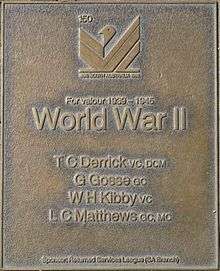Bill Kibby
| William Henry Kibby | |
|---|---|
|
William Kibby | |
| Born |
15 April 1903 Winlaton, County Durham, England |
| Died |
31 October 1942 (aged 39) El Alamein, Egypt |
| Buried | El Alamein War Cemetery |
| Allegiance | Australia |
| Service/ | Australian Army |
| Years of service | 1936–42 |
| Rank | Sergeant |
| Battles/wars |
Second World War |
| Awards | Victoria Cross |
William Henry "Bill" Kibby, VC (15 April 1903 – 31 October 1942) was a British-born Australian recipient of the Victoria Cross, the highest award for gallantry in the face of the enemy that can be awarded to British and Commonwealth forces.
Early life
Kibby was born at Winlaton, County Durham, England on 15 April 1903. In early 1914, the family emigrated to Adelaide, South Australia, where Bill attended Mitcham Public School. After leaving school he was employed at a plasterworks in Edwardstown, where he designed and fixed plaster decorations. In 1926, he married Mabel Sarah Bidmead Morgan; they had two daughters.
Although he was diminutive (168 cm (5 ft 6 in)), Kibby was a strong man and loved outdoor activities. In 1936, he joined the Militia, and was assigned to the 48 Field Battery, Royal Australian Artillery.
Second World War


Kibby joined the Second Australian Imperial Force during the Second World War. In 1942, he was a sergeant in the 2/48th Infantry Battalion, during the North African campaign.
At the Second Battle of El Alamein, during the period of 23–31 October 1942, Kibby distinguished himself through his skill in leading a platoon, after his commander had been killed, during the initial attack at Miteiriya Ridge. On 23 October, he charged a machine gun position, firing at it with his Thompson submachine gun; Kibby killed three enemy soldiers, captured 12 others and took the position. His company commander intended to recommend him for the Distinguished Conduct Medal after this action, but was killed. During the following days, Kibby moved among his men directing fire and cheering them on. He mended his platoon's telephone line several times under intense fire. On 30–31 October, the platoon came under intense machine gun and mortar fire. Most of them were killed or wounded. In order to achieve his company's objective, Kibby moved forward alone, to within a few metres of the enemy, throwing grenades to destroy them. Just as his success in this endeavour appeared certain, he was killed.[1]
His Victoria Cross was awarded posthumously and is displayed at the Australian War Memorial. He is buried at the Commonwealth War Grave at El Alamein.
Two myths
Most VC works produced in Britain in the 20th Century with the notable exception of Victoria Cross battles of the Second World War by C E Lucas Phillips incorrectly locate Miteiriya Ridge in Libya.[2] The four infantry divisions of XXX Corps, north to south, 9th Australian, 51st Highland, 2nd New Zealand and 1st South Africa staged behind Miteiriya Ridge for the opening infantry assault of the Battle of El Alamein on the night of 23 October 1942.
Complete VC works published in the last 15 years, Symbol of courage in 2004, the Complete Victoria Cross in 2010 and the Victoria Cross and George Cross: the complete history in 2014 all state Egypt but VCs of the north in 2015 still has Libya. Close to where Kibby fell was the body of his company commander, Captain Peter Robbins. VCs the north states ‘In his pocket was a note recommending Kibby for the VC’. This myth would seem to be an embellishment of the circumstances included in the 2/48th battalion history. After the battle, a note written by Captain Peter Robbins was found to say ‘And if I’m killed tonight, recommend Bill Kibby for the DCM for what he did on the 25th’.[3]
Postscript
While in Palestine Kibby, who had some talent as an artist, struck up a friendship with painter Esmond George and accompanied him on the occasional sketching trip. George was invalided back to Adelaide early in 1943, and was able to pass on to Mrs. Kibby some of her husband's works.[4]
In 1944 a Sgt. Kibby Memorial Trust was set up and raised ₤1001, which was used to purchase a house on Third Avenue Helmsdale (now Glenelg East) for Mrs. Kibby and their children.[5]
See also

References
- ↑ "No. 35879". The London Gazette (Supplement). 26 January 1943. p. 523.
- ↑ C E Lucas Phillips. Victoria Cross battles of the Second World War, William Heinemann Ltd. London, 1973, ISBN 978 0 434 43658 3. The tables in Sir John Smyth’s 1963 work The Victoria Cross lists the place of action as Western Desert which is how it is also described in the War Office 1953 List or the recipients of the Victoria Cross.
- ↑ Alan Whitworth. VCs of the north: Cumbia, Durham & Northumberland, Pen & Sword, 2015, ISBN 978 1 47384 822 1, pp. 92-93; Tobruk to Tarakan: the story of a fighting unit; Rigby Limited, Adelaide, 1960, p. 167.
- ↑ "Out Among the People". The Advertiser (Adelaide). LXXXV, (26319). South Australia. 11 February 1943. p. 4. Retrieved 24 February 2017 – via National Library of Australia.
- ↑ "House for V.C's Dependants". The Advertiser. Adelaide, South Australia. 15 January 1945. p. 6. Retrieved 24 February 2017 – via National Library of Australia.
External links
- Bill Gammage, 'Kibby, William Henry (Bill) (1903–1942)', Australian Dictionary of Biography, Volume 15, Melbourne University Press, 2000, pp 15–16.
- Sergeant W.H. Kibby in The Art of War exhibition at the UK National Archives